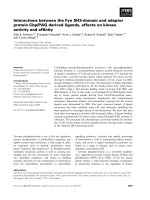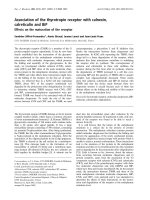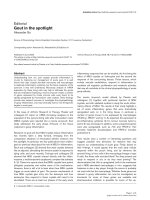Báo cáo y học: "Living on the edge" pps
Bạn đang xem bản rút gọn của tài liệu. Xem và tải ngay bản đầy đủ của tài liệu tại đây (52.53 KB, 2 trang )
Genome Biology 2005, 6:307
comment
reviews
reports
deposited research
interactions
information
refereed research
Meeting report
Living on the edge
Gino Poulin and Julie Ahringer
Address: The Gurdon Institute and Department of Genetics, University of Cambridge, Tennis Court Road, Cambridge CB2 1QR, UK.
Correspondence: Gino Poulin. E-mail:
Published: 14 January 2005
Genome Biology 2005, 6:307
The electronic version of this article is the complete one and can be
found online at />© 2005 BioMed Central Ltd
A report on the Second EMBL/EMBO Symposium on
Functional Genomics: ‘Exploring the Edges of Omics’,
European Molecular Biology Laboratory (EMBL), Heidelberg,
Germany, 16-19 October 2004.
EMBL’s recent symposium on functional genomics showed
how this new field has matured. Work from a broad range of
model organisms provided new biological insights, and a
plethora of improved high-throughput technologies promised
more of these in the future. We focus here on biological net-
works - a major theme of the meeting.
Network motifs
The identification of patterns in biological data can uncover
mechanisms through which processes are regulated. Uri
Alon (Weizmann Institute of Science, Rehovot, Israel) pre-
sented evidence that in gene-regulatory networks particular
patterns of interconnections (network motifs) are enriched
when compared to a randomized network. For example, the
three-node feed-forward loop, in which transcription factor
X regulates transcription factor Y and both jointly regulate
gene Z, is a frequently used network motif; one example is in
the
L-arabinose utilization system in Escherichia coli. Study-
ing this system in vivo Alon found that the feed-forward loop
is protected against fluctuation of external signals and allows
rapid shutdown of transcription. The identification of
network motifs is important, as they are thought to perform
specific information-processing tasks.
Dissecting networks involved in complex contexts such as
animal development is a monumental task. Norbert Perri-
mon (Harvard Medical School/Howard Hughes Medical
Institute, Boston, USA) reported how his group is starting to
tackle network complexity by carrying out genome-scale
loss-of-function analysis in Drosophila cells using RNA
interference (RNAi). The strategy is to perform multiple
RNAi screens in different defined contexts (different cell
lines or different stimuli) using sensitive and reliable
reporter assays. Perrimon focused on canonical signaling
pathways such as those involving Jaks and Stats, Wingless
(Wg) and Hedgehog. From these systematic screens it
appears that there are important overlaps between the path-
ways, and that the signaling components forming these path-
ways, are more numerous than expected. These findings were
illustrated in a network topology map where, for example, 32
components are shared in the Wg and Hedgehog screens, but
only two are shared between Wg, Hedgehog and Jak-Stat
screens. To try and organize the data, a phenoprint matrix (a
color-coded matrix that visually links phenotypes to genes) is
being built, which at the moment encompasses about 20
genome-wide screens and more than 7,500 genes. This
impressive work showing unexpected connections chal-
lenges our current view of how signal information is trans-
duced to form an appropriate response.
An important role of biological networks is transcription
regulation. Understanding how DNA-binding transcrip-
tional regulators interpret the genome’s regulatory code is
essential. Richard Young (Whitehead and Broad Institutes,
Massachusetts Institute of Technology, Cambridge, USA)
reported the use of genome-wide location data (ChIP-chip)
combined with phylogenetic conservation data to describe
the promoter architecture and the global behavior of tran-
scription factors in Saccharomyces cerevisiae. Four types of
architectures were found: single regulators; repetitive
binding motifs; multiple regulators; and co-occurring regu-
lators. There are also four global behaviors: condition invari-
ant (the transcription factor binds the same targets
regardless of the environment tested); enabled (the tran-
scription factor does not bind its target until enabled by the
environment); expanded (the binding pattern is expanded
by changes of environment); and altered (different targets
depending on the environment). Of particular interest, it
was estimated that 17% of DNA-binding factors are found on
specific targets but wait for a signal before regulating tran-
scription. This work will provide an excellent framework for
modeling global gene expression in other eukaryotes.
Network hubs
Networks have particular nodes that are more highly con-
nected than others; these nodes are called hubs. Marc Vidal
(Dana-Farber Cancer Institute, Harvard Medical School,
Boston, USA) described the use of large-scale yeast two-
hybrid mapping to derive a protein-interaction network in
which he found two types of hub, which behave differently.
The first type is called the ‘party’ hub, and has numerous
partners that interact with it simultaneously. The second
type is the ‘date’ hub, which also has many potential part-
ners, but where the interacting partners depend on location
and time. The date hubs represent high-level connectors
between structural or functional modules such as cellular
organelles or particular pathways, whereas party hubs func-
tion inside these modules, at a lower level. In yeast, for
example, calmodulin is a date hub that connects four differ-
ent modules, while one of these modules, the endoplasmic
reticulum, forms a party hub.
Stuart Kim (Stanford University, USA) has uncovered hubs
through analyzing DNA microarray data for conserved gene
co-regulation. These hubs, which he calls ‘subunits’ and
‘integrators’, also have different properties: subunit compo-
nents are highly interconnected whereas integrator hubs
have a central connection point with few connections
between components. Also, subunit components are usually
essential, whereas most integrator components are not, sug-
gesting that these latter proteins may have partially redun-
dant functions. He also presented evidence that newly
evolved genes are not found in hubs. The uncovering of dif-
ferent properties for different types of hub is fundamental
for further studies of biological networks.
The microRNA network
MicroRNAs (miRNAs) regulate gene expression and are
found in all metazoans studied so far. Three presentations
addressed different aspects of miRNAs: identification of
their targets; identification of novel miRNAs; and analysis
of their biological functions. Steve Cohen (EMBL, Heidel-
berg, Germany) presented the results of systematic in vivo
analysis of miRNA/target pairing characteristics in
Drosophila. It was determined that the 5Ј end of the
miRNA is the most important in pairing and that a
minimum of seven pairing nucleotides is required for
silencing. Three types of target were also identified: canon-
ical (perfect pairing), seed (fork-like) and compensatory
(bubble-like). He estimated that half of the genes in the
genome are regulated through miRNAs.
How miRNAs work is still not entirely defined. Ronald
Plasterk (Hubrecht Laboratory, Utrecht, The Netherlands)
has used RNAi in Caenorhabditis elegans to identify genes
required for miRNA function. His laboratory used a reporter
gene (lin-14::lacz) that is regulated by the miRNA let-7. In
this system, when let-7 becomes expressed, the level of
expression of the protein LACZ diminishes because of a
translational inhibition of the reporter gene. Using a candi-
date-based approach that relies on previous genome-wide
RNAi screens, 508 genes were tested by RNAi for causing an
absence of silencing; 25 new genes were found with this
property, one of which is the gene encoding the small
ubiquitin-like modifier protein SUMO.
Victor Ambros’s laboratory (Dartmouth Medical School,
Hanover, USA) is studying the biological function of miRNAs
by generating deletions of the miRNA genes in C. elegans. He
described how, by studying miRNA loss-of function pheno-
types, miRNA activities have been grouped into four classes:
coordinated (repression of multiple targets); collaborative
(multiple miRNAs acting on common targets); redundant;
and modulated. Redundancy within the let-7 family was
shown; double mutants between the two let-7 family
members mir-48 and mir-84 display a phenotype, but the
single mutants do not.
The meeting was inspiring, presentations were of very high
quality and participants were able to interact in a relaxed and
comfortable atmosphere. The field of functional genomics
has truly become ‘functional’ and we can look forward to
hearing more at the next symposium.
Acknowledgements
G.P. is supported by the Wellcome Trust and J.A. is a Wellcome Trust
Senior Research Fellow (054523).
307.2 Genome Biology 2005, Volume 6, Issue 2, Article 307 Poulin and Ahringer />Genome Biology 2005, 6:307









